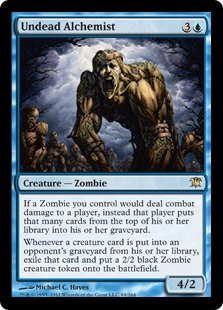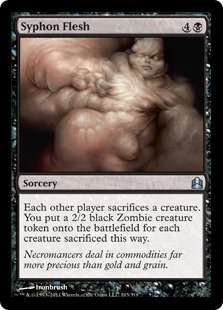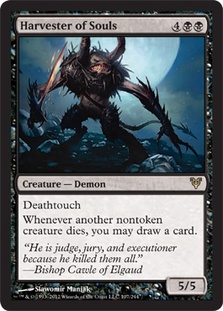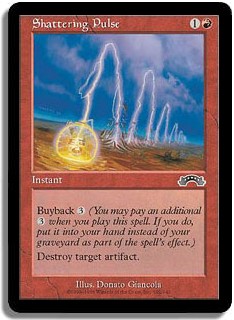EDH was a format named after legendary creatures from the first set of Magic that included them: legends. I’ve wanted to build a Commander deck around an old-school legendary creature for a while, and today I decided to scratch that itch. When looking at some interesting older legends, I saw Lord of Tresserhorn, and I again fell in love with how wonky and powerful it seems. Could I build a decent Tresserhorn deck? Let’s find out!
Since I’m building around the Lord of Tresserhorn, the first thing I wanted to do was to add a few cards that eliminate his negative enter the battlefield triggers. The first is the powerful Torpor Orb. All enter battlefield triggers don’t happen when a creature arrives if a Torpor Orb is in play. Not only does that mean that our Commander is now a 10/4 legendary creature with regeneration for just four mana, but it also means that all other triggers are gone. Casual players love their triggers, and this hoses everything from Eternal Witness to Acidic Slime, Aura Shards to Shriekmaw, and Solemn Simulacrum to Karmic Guide. Turning off these abilities is a powerful way to hose a lot of cards in others’ decks, but I have to build around it. I don’t want Torpor Orb messing up my own creatures.
The other good way to keep the Lord from doing damage to my team is by playing Illusionary Mask. This highly unusual card from the first set is so complex that it had to have its meaning and wording changed numerous times over the course of Magic. This card underwent a huge foundational shift in what it did after morph was released as a mechanic, and it made the artifact more tournament friendly and less casual friendly. It could work in this deck because you can play the Lord face down as a morphed 2/2 creature and then flip it up when you target it, tap it, yadda yadda. But then I checked the ruling, and you can only use Illusionary Mask on cards in your hand, not in general (no Command Zone), thus you cannot use it on the Lord. Well, there went that idea. So it’s just the Torpor Orb for this deck.
Since Torpor Orb hoses a lot of cards in various decks (as well as a few strategies such as Angelic Chorus, Wild Pair or Pandemonium), I felt it was a good place to add a bit of hosing as well. Planar Void and Leyline of the Void really attack any deck which wants to regurgitate cards from the graveyard. It hurts cards with flashback, Reanimation plans, and more. Since the Leyline does not hurt me, only the Planar Void does, I’ll still include a small number of cards that use my own graveyard. I don’t expect the Planar Void to be in play for the whole game or anything. Opponents will take it out if it becomes too bothersome.
I decided to push my hosing theme to red. Mono-red Commander decks have three nasty tools against multi-color Commander decks because of their reliance on nonbasic lands: Magus of the Moon, Blood Moon, and Ruination. Any multicolor deck can fight this by playing more basic lands. Knowing that, I tossed these three cards in, and I eventually only wound up with four nonbasic lands. Turning one into a Mountain is fine since I have red cards in my deck that can use the mana. In order to fetch these basic lands, I can’t rely on Solemn Simulacrum or Pilgrim’s Eye due to the Torpor Orb. Instead, I have the very powerful Gem of Becoming and Armillary Sphere to Tutor multiple basic lands. How do I make sure I find them? Excellent question; see below! (I also included Jhessian Zombies and Igneous Pouncer to search a land when needed and to add some searching redundancy to the deck).
Since Illusionary Mask was out, I wanted ways to mitigate against the Lord’s disadvantages for when Torpor Orb is destroyed or cannot be found. I rocked good creatures for Commander that also made dorks for me. I didn’t want any of these to suck or to be in here just for their critter-making abilities. Take Grave Titan, for example. He’s a solid choice in multiplayer, and even if an Orb is out he’s a good body who makes Zombies when he swings. Another great choice is Oona, Queen of the Fae. Not only does she have a nice-sized flying body, but she also exiles cards from decks at a prodigious clip while spitting out Faerie tokens. She can make enough bodies to sacrifice to the Lord.
Another great creature that brings some friends is Talrand, Sky Summoner. We’ve already seen how many dorks he can make in his short time in Commander. He has the power level to make the cut in this format easily and gives me Lord fodder. Meloku the Clouded Mirror is a card with a powerful tournament pedigree who also has serious power in the late game as you pull up lands for bodies. Why not use a few of those bodies to bring the Lord back out?
After that, I went with some token makers I really enjoy. Rakka Mar is amazing. She taps for one mana to make a 3/1 with haste. A lot of people miss what she does because they think her token dies at the end of the turn, but it doesn’t. She just keeps making 3/1 hasted dudes. That’s a powerful, quick army which adds fuel to the fire for my Commander while also being good on her own. Bloodline Keeper is a decently sized flyer, and for no mana down you can tap him to produce a 2/2 Vampire. I don’t have a lot of Vampires in the deck to enable him to transform easily, but since he makes dudes mana-free he’s good on his own. If I happen to create a big enough army, he can flip to really add some damage capacity to my team.
Then I went with a few more creatures that make dudes in other ways. Rapacious One will spew out a ton of 0/1 Eldrazi spawn if it hits a foe. With trample on the body already, that’s almost a given. I steered clear of the other Eldrazi drone-makers because they mostly suck in these colors. Kazuul is a fine multiplayer card that can force people to make a 3/3 Ogre for you when they attack. They often just head somewhere else, so you can’t rely on him making tokens for the sacrificing, but he can.
One creature that we need to discuss a bit is Undead Alchemist. I decided to add a trick to the deck with its inclusion. Whenever a Zombie deals combat damage to a foe, you mill that many cards and make 2/2 dudes for every creature that is milled. The creatures milled are exiled (and this works on any creature card placed into an opponent’s graveyard from their library, not just the ability from Undead Alchemist—so if someone uses Sands of Delirium to make another mill seven cards, any creature cards are exiled and you spit out tokens).
The only creature type the Lord of Tresserhorn possesses is Zombie, so he can hit and make an army all on his own. This also impacts creatures such as Jhessian Zombies, Grave Titan, and so forth. There are not that many Zombies in the deck and you have to be careful with him because the creatures won’t deal damage. If you want the ten Commander damage from the Lord or just the ten damage to the face, then don’t drop it. But it’s a nice surprise out of nowhere and can mill a deck very quickly (especially if combined with Oona or more Zombies).
I included a few creatures that I don’t mind sacrificing. Wonder and Anger are here for when I don’t have a Planar Void out. They are happy to linger in my graveyard and give my creatures flying and haste, respectively. I have few natural flyers in my deck, so Wonder is particularly nice. Tuktuk the Explorer is a humble 1/1 with haste in red. When he dies, you make a 5/5 Golem token. You can sacrifice him to make Tuktuk the Returned. It’s not a very large number of creatures, I’ll grant you, but it’s nice to have these options.
I don’t really care as much about the life loss to the trigger the Lord has, and the cards to another player are a nice way of mitigating his power and enabling others to be happy so it’s not a big deal either. So I looked for more good ways of token making. Some noncreatures are also good at making the tokens. Bitterblossom forces one to lose a life and make a 1/1 flying body each turn. The life loss is negligent, while the bodies serve for either damage or the cause. You produce exactly two Faeries by the fourth turn, so you can play the Lord if you have the right mana. Perfect!
Rite of Replication is a sorcery that’s quite strong in Commander, as many decks have attested. You can make a bunch of tokens of something later in the game and then use them if you need. Or you can just play the card as normal without missing a beat. Batterskull makes a Germ token, which is easily sent to the great beyond when the Lord calls. Then you can bounce it and replay it for another or just equip the Lord. Do you know how nasty a Lord of Tresserhorn is with a Batterskull equipped to it? Just let me attack with my 14/8 vigilance lifelink regenerator for a bit please!
There are a couple of unusual token makers to discuss. Syphon Flesh is fine as a way to force all foes to sacrifice one creature each and to make 2/2 Zombies from their death. It’s good as removal and token producing. Another card I included is the underused Din of the Fireherd. I’m a bit surprised that I don’t see this more in black and red Commander decks. Let’s look under the hood. This is an eight-mana sorcery which is very easy to cast on the mana base. It makes a 5/5 black and red Elemental token. That’s about three more mana than you would expect because no one would play a six-mana sorcery that only makes a 5/5 dork, but a five-mana one would be in consideration.
What do you harvest for your three extra mana investment? A target opponent has to do two things: sacrifice a creature for each black creature you control and sacrifice a land for each red creature you control. You’ve seen how many ways I have to make a bunch of extra black creatures, so the first ability is possibly a one-sided Wrath of God. Even when it’s not, you made a token with the Din so you always Edict for at least one. Similarly, you always force the sacrifice of at least one land. I don’t have a lot of red creatures in the deck, so this mostly hits for potentially huge amounts of creatures but likely just one land. That’s worth the price of admission since I make a beater and always force a foe to sacrifice at least two permanents; that’s card advantage even in the worst-case scenario.
At first, Army of the Damned may not look good because you can’t flash it back if it’s exiled with Planar Void. But since it makes enough Zombies to slay in two turns of combat, it still seems pretty saucy. Imagine it with Undead Alchemist—it might take an extra turn or two to kill your first target, but you’ll have something like forty 2/2s out to finish the rest of the table in one or two hits total! (Plus they kill someone with a really high life total by slamming the library.)
Since I had all of this token making, I felt I should add a few cards into the deck that also use creatures as fuel. The first was Magmaw. It can sacrifice any nonland permanent for a mana and spit out a damage on the other side. It’s also a serviceable 4/4 creature on a five-mana body. It allows you to sacrifice problematic cards if they become a burden, such as Bitterblossom after you drop too low in life. The next one I included was Carnage Altar. For three mana, any time I want I can turn a creature into a card. It’s repeatable and easy on the mana. In the late game, you can do funky tricks such as play Batterskull, sacrifice the germ token for a card, and return it to your hand to do again. Sure, it sucks up a bunch of mana, but if you possess the resources, why not have options with it?
I like to kill creatures as much as the next person, so in went both Avatar of Woe and Stronghold Assassin. The first won’t likely be played for its cheap cost, but it still is worth the price at its normal eight mana. The Assassin can sacrifice a creature to slay any creature. It can come down early and then harness the creatures we have.
I added a few cards that work with the theme I had built up. The first was Thraximundar. Not only is he a fine card on his own, but whenever a creature is sacrificed he pumps permanently. Normally you are using that off his own trigger to force the sacrifice of an opposing dude when he attacks, but he also works very well with Stronghold Assassin, Magmaw, Carnage Altar, Syphon Flesh, Din of the Fireherd, Lord of Tresserhorn, and even sacrificing Eldrazi tokens for mana.
Another card that works very well in this deck is Butcher of Malakir. I wish I had space for Grave Pact as well, but I don’t—the deck is too tight. This works fine though. You have a flying beater who has enough size to matter in the red zone. As our creatures die, others are forced to sacrifice theirs. In this deck, that’s a huge chance of smashing opposing forces and adding hits in. Another amazing critter for this deck is the Harvester of Souls. With so many creatures dying, making a card for free each time is like money in the bank. Then add the deathtouch of the creature and a 5/5 body for six mana, and we have a major player. Please note that you don’t draw cards when tokens die, because that would be downright broken. But when you see how many creatures die one after another, you won’t notice.
One card that is broken is Skullclamp. With many ways of making mass amounts of tokens with one toughness, you can turn a Faerie token from Bitterblossom or Oona, an Elemental token from Rakka Mar, or an Eldrazi drone from Rapacious One into serious card advantage. (I also add two more token makers that will make small Clamp-able dudes later). Toss it on any creature about to be sacrificed to the Lord for two cards for you in addition to two cards for a foe to even things out a bit. It breaks this deck in half. Imagine putting it on a creature, having out Harvester, and sacrificing that creature to a Carnage Altar—four cards for one sacrifice!
I rounded out my creature collection with Darksteel Sentinel. Then I moved to noncreature artifacts. I knew that I wanted to Tutor Torpor Orb as much as possible, so in went ways of finding it. Transmute Artifact was added as an artifact Tutor, and both of the Tezzerets are nice additions to the deck as planeswalkers. I can also use them to find a vital Gem of Becoming or Armillary Sphere if needed. With Skullclamp as broken as it is, it became obvious that this sort of artifact enabling would be a nice subtheme.
To work with that theme, I added Sensei’s Divining Top and Trading Post. The Post is amazing in this deck because you can make a 0/1 Goat token, you can bring back an artifact if you have a graveyard still up and running, you can draw a card, or you can gain four life, whichever you have fuel for. Since the recursion of an artifact requires the sacrifice of a creature, it came in on-theme. All of the abilities work in this deck very well, including the life gain which fights against both the Lord’s loss of life and Bitterblossom’s.
Next came artifact mana. Sol Ring was obvious, and I also included Gilded Lotus for mana smoothing, followed quickly by Thran Dynamo and Dreamstone Hedron. These all give me some good mana options, and the Sol Ring is a fine Tutor target for something like Tezzeret the Seeker. Lastly, I wanted Vedalken Orrery in the deck. I love playing things with flash, it’s so freeing. It gives me another artifact for the deck, which helps, and I can search it up if needed. In fact, I liked the ability so much in this deck that I also added Leyline of Anticipation.
I needed removal, but I didn’t have a lot of spots for it. Both of my artifact removal options can off multiple threats. The first is Into the Core. It’s a very reasonable four-mana instant that exiles two artifacts. This gives you a permanent answer to two threats at the table. The other is Shattering Pulse. With buyback, you can blow up one artifact after another as you have need. These should help keep you and yours safe from the artificial.
I looked at pinpoint creature removal, such as Murder or Terminate, but ultimately I decided to rock a few mass removal options. Life’s Finale is amazing in this deck. You kill the table, and then you can pull out three creatures from an opponent’s deck into their graveyard. If you have out something like Planar Void, they will be exiled and you won’t have to worry about them. If you see recursion in their deck, then you can instead just skip the Tutoring and shuffle their deck. I just wish there was a way to have Undead Alchemist in play as you pull out the creatures, but by then it’s died. Then you could exile the three choices and manufacture three 2/2 Zombies off them! The rest of the mass removal is par for the course: Damnation, Black Sun’s Zenith, and Decree of Pain.
This deck really wanted two more planeswalkers. Nicol Bolas is obviously powerful and a must-include. Another must-have is Karn Liberated. Both of these shore up various weaknesses in the deck. For example, Karn can exile any permanent, including a major land or enchantment or enemy planeswalker. What Karn exiles, Nicol Bolas just destroys (as long as it isn’t a creature—he’ll just steal creatures). Both give the deck answers to permanent threats while being threats of their own. I never use Karn’s ultimate; I just use him as a discard or permanent destruction machine. Trust me, he’ll be taken out by someone quickly enough as it is!
Some card drawing was deemed necessary. I usually play Fact or Fiction in these sorts of decks, but here I didn’t like it. Instead Opportunity was included, as was Tidings and Recurring Insight. Other cards to round out the deck are Demonic Tutor and the potent late game Diabolic Revelation. With room for just one card after all of this, in went Slaughter as an emergency piece of pinpoint removal that I can easily buyback to use again and again.
I only had space for four nonbasic lands since I didn’t want to risk losing much to my own Ruination. The first two are the powerful Volrath’s Stronghold and Academy Ruins. Both have powerful casual pedigrees, and both are so good that it’s worth running them even if my cards may be exiled from a Planar Void or the lands may be hit by a Ruination. My other two lands make dudes, as Kher Keep provides Kobold tokens to the field and Hellion Crucible can make bigger bodies over time. They fit very cleanly into the deck as a whole, and they add so much that I had to toss them in.
Let’s take a look at the deck!
Creatures (24)
- 1 Avatar of Woe
- 1 Meloku the Clouded Mirror
- 1 Shadowmage Infiltrator
- 1 Wonder
- 1 Anger
- 1 Lord of Tresserhorn
- 1 Stronghold Assassin
- 1 Magus of the Moon
- 1 Oona, Queen of the Fae
- 1 Rakka Mar
- 1 Thraximundar
- 1 Jhessian Zombies
- 1 Igneous Pouncer
- 1 Butcher of Malakir
- 1 Kazuul, Tyrant of the Cliffs
- 1 Magmaw
- 1 Rapacious One
- 1 Tuktuk the Explorer
- 1 Grave Titan
- 1 Darksteel Sentinel
- 1 Undead Alchemist
- 1 Bloodline Keeper
- 1 Harvester of Souls
- 1 Talrand, Sky Summoner
Planeswalkers (4)
Lands (36)
Spells (36)
- 1 Sensei's Divining Top
- 1 Sol Ring
- 1 Demonic Tutor
- 1 Transmute Artifact
- 1 Opportunity
- 1 Tidings
- 1 Decree of Pain
- 1 Skullclamp
- 1 Blood Moon
- 1 Planar Void
- 1 Gilded Lotus
- 1 Vedalken Orrery
- 1 Ruination
- 1 Slaughter
- 1 Shattering Pulse
- 1 Thran Dynamo
- 1 Leyline of the Void
- 1 Damnation
- 1 Bitterblossom
- 1 Din of the Fireherd
- 1 Armillary Sphere
- 1 Carnage Altar
- 1 Rite of Replication
- 1 Dreamstone Hedron
- 1 Recurring Insight
- 1 Leyline of Anticipation
- 1 Into the Core
- 1 Black Sun's Zenith
- 1 Batterskull
- 1 Torpor Orb
- 1 Life's Finale
- 1 Syphon Flesh
- 1 Army of the Damned
- 1 Diabolic Revelation
- 1 Gem of Becoming
- 1 Trading Post

I had countermagic in here for a bit, but it was just four or five cards and that wasn’t enough. I had to either commit to counters or pull them, so I ripped them out for more good stuff. I really like how the deck looks, and I hope you do too! Enjoy the deck, and tell me what you like or don’t like about it.
Until later,
Abe Sargent





